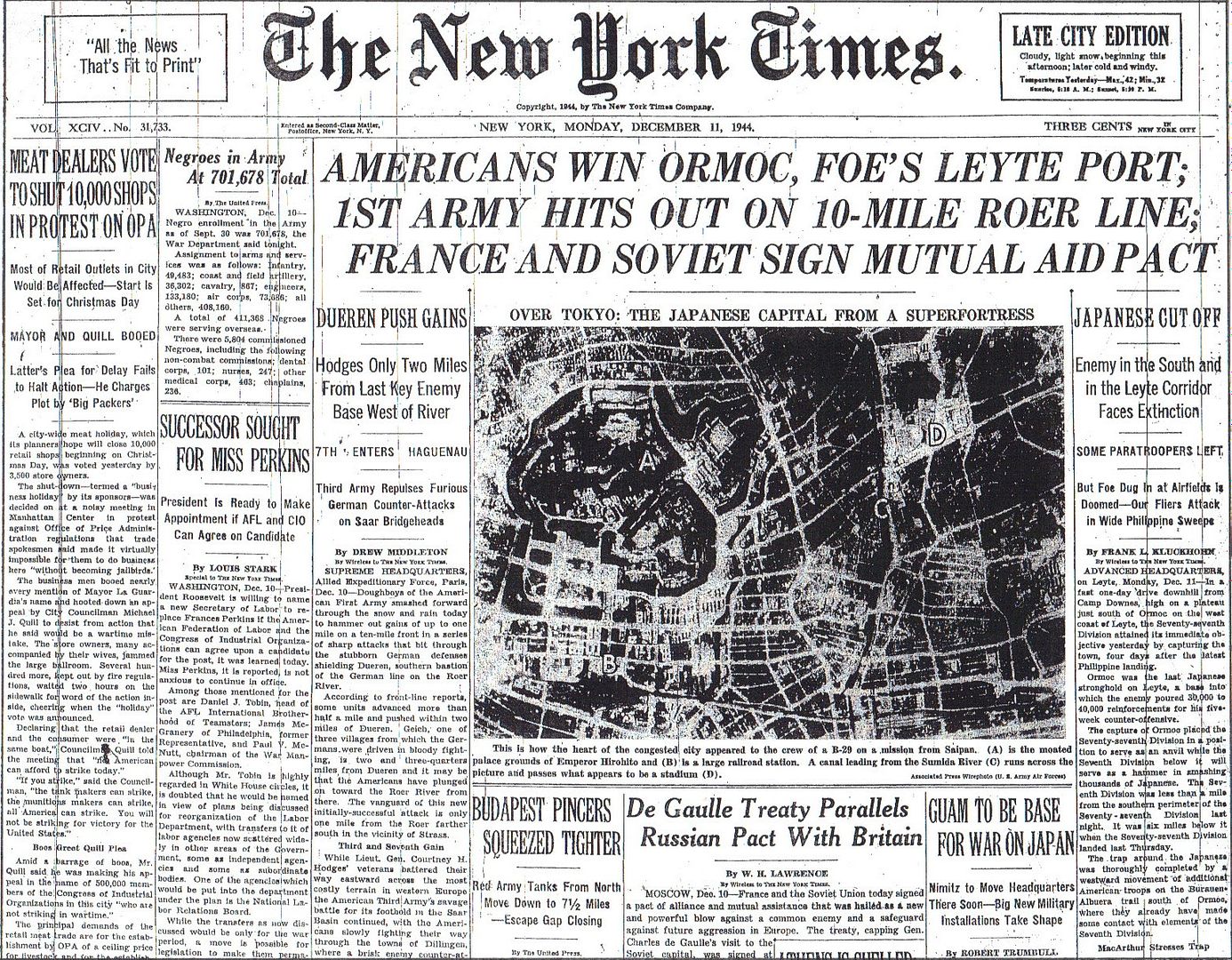
Posted on 12/11/2014 4:29:52 AM PST by Homer_J_Simpson

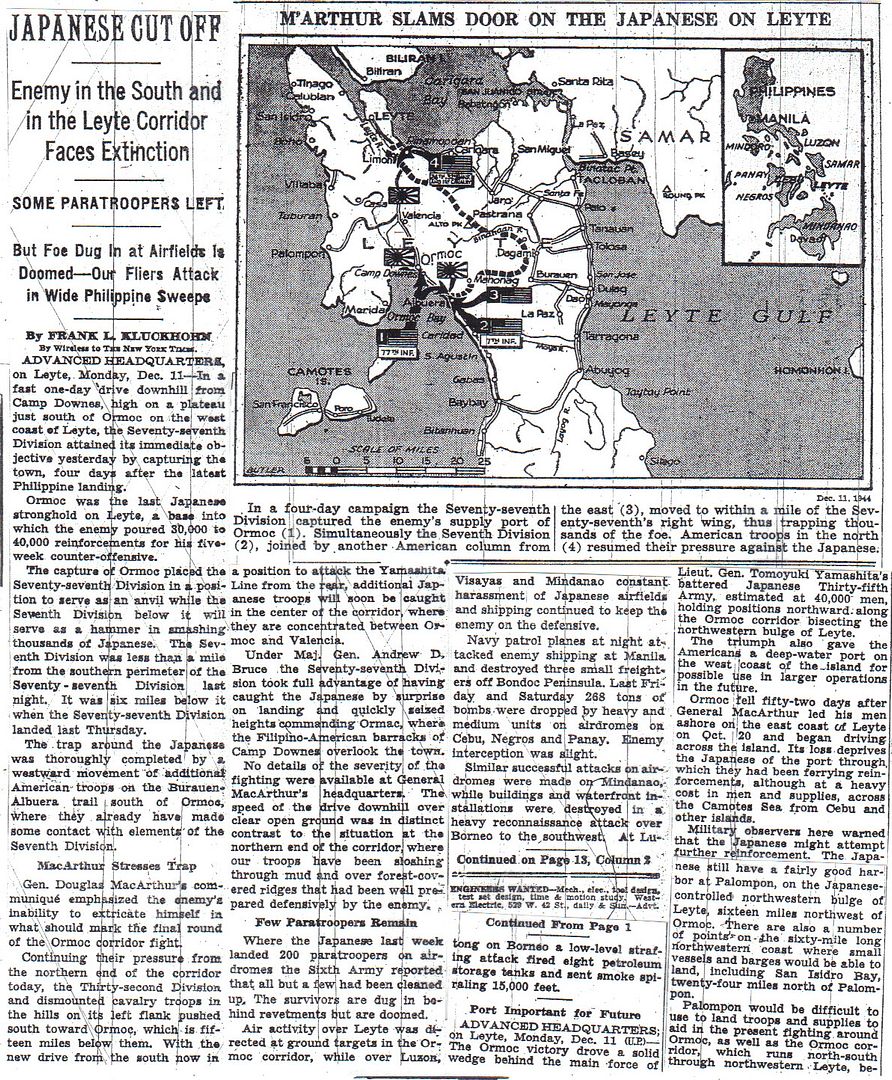
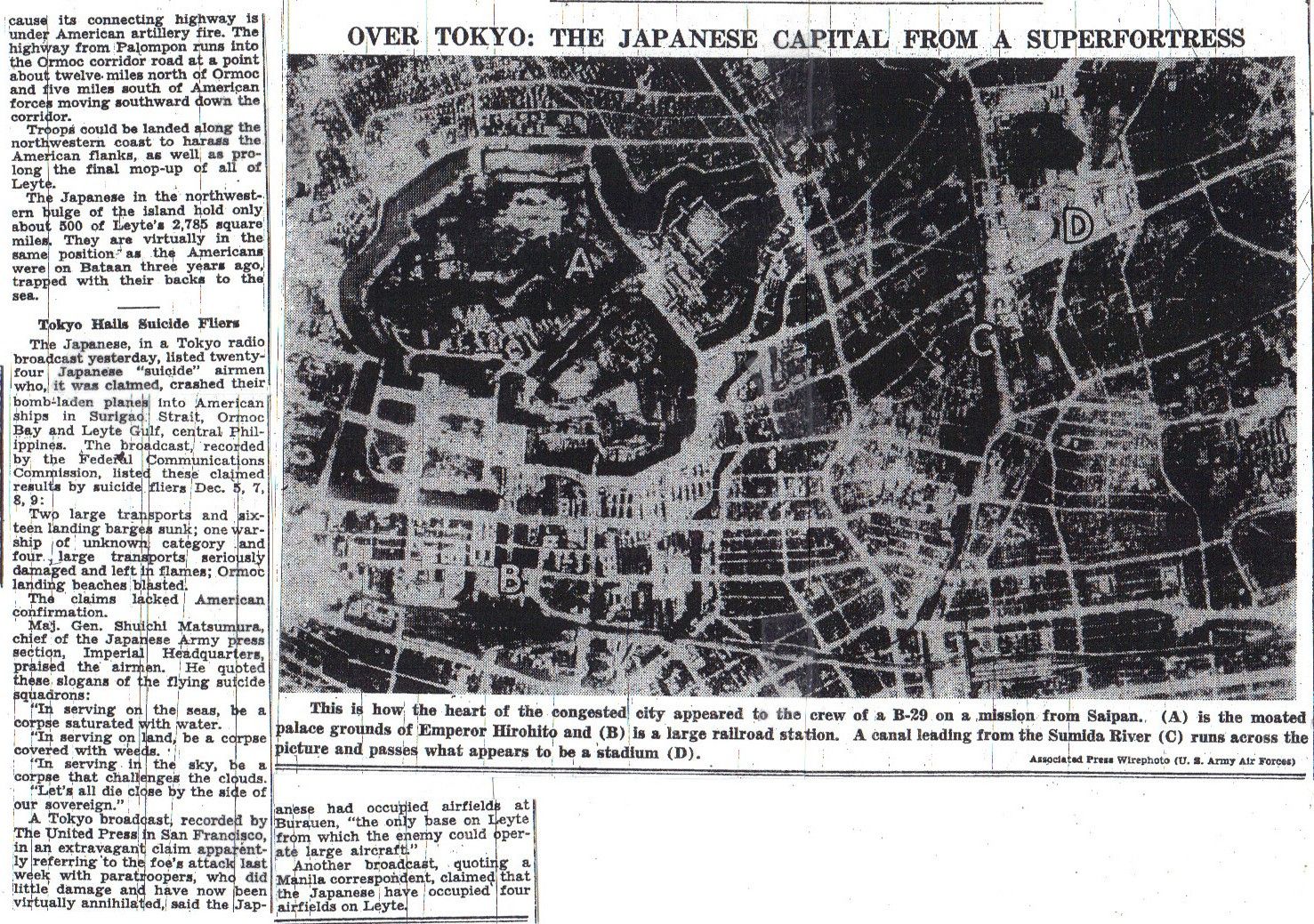
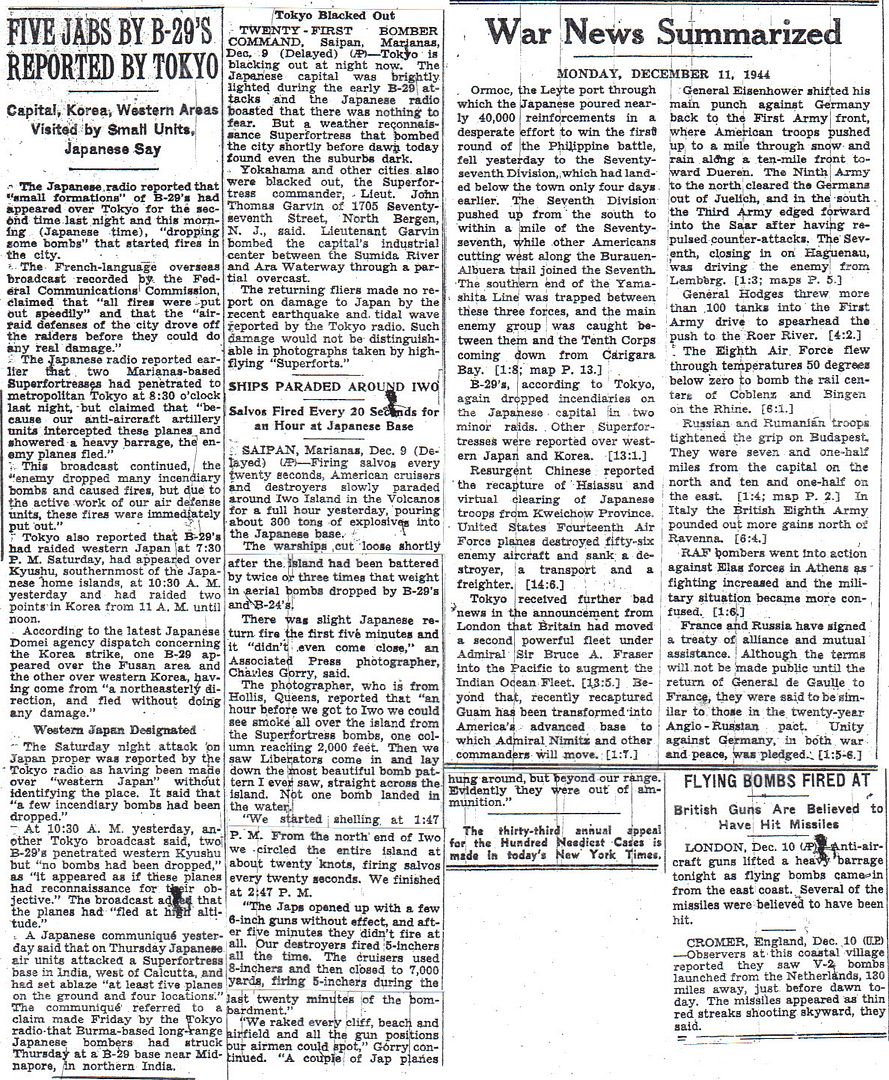

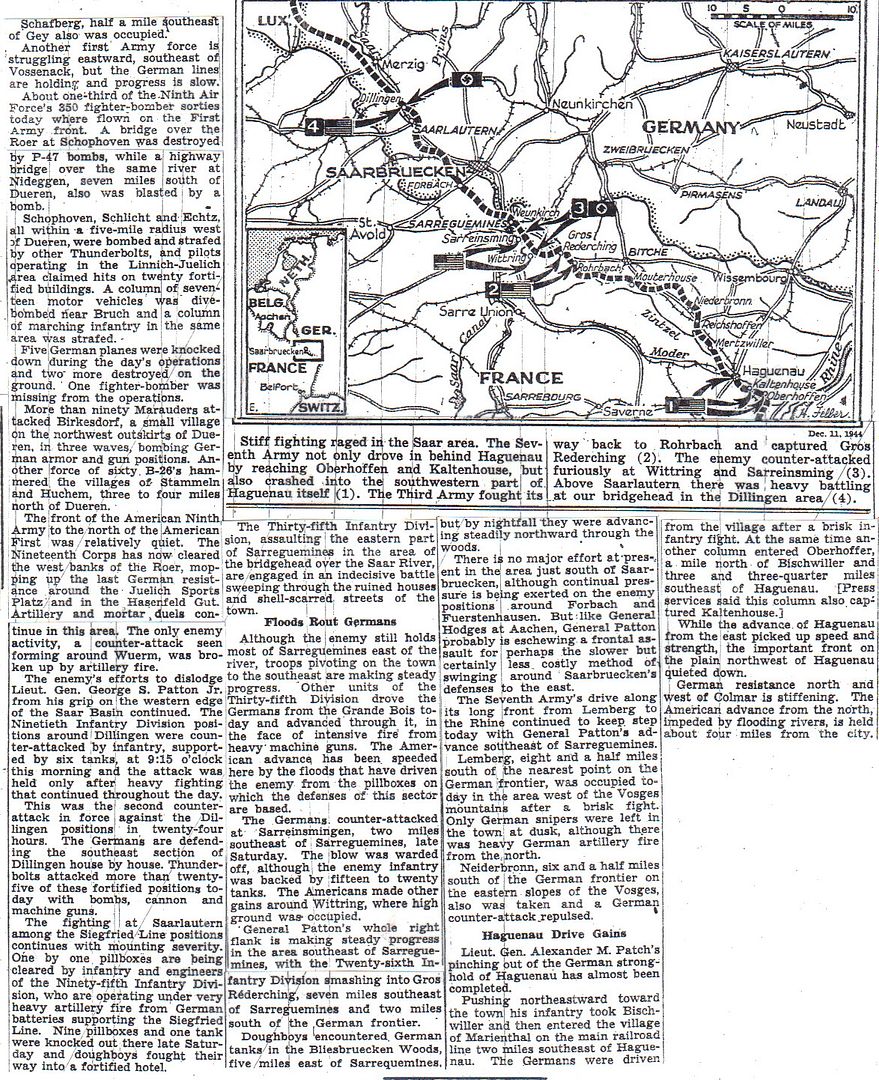
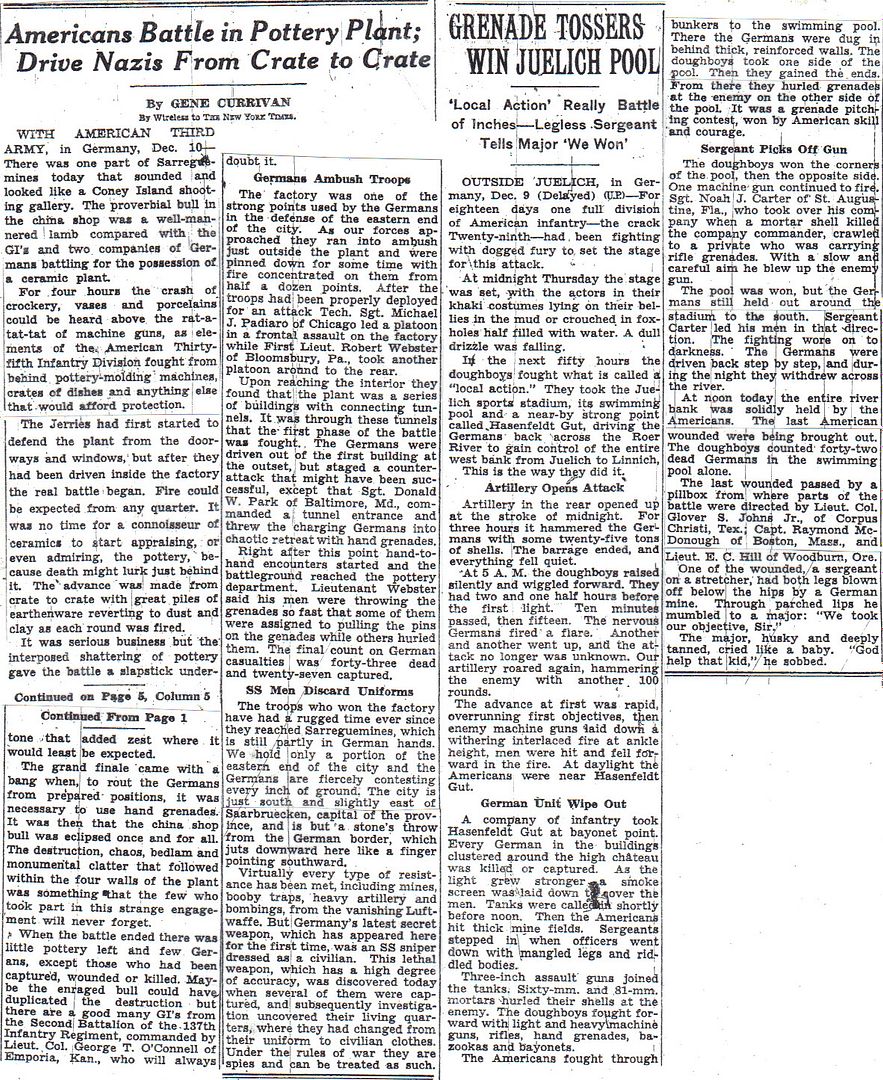
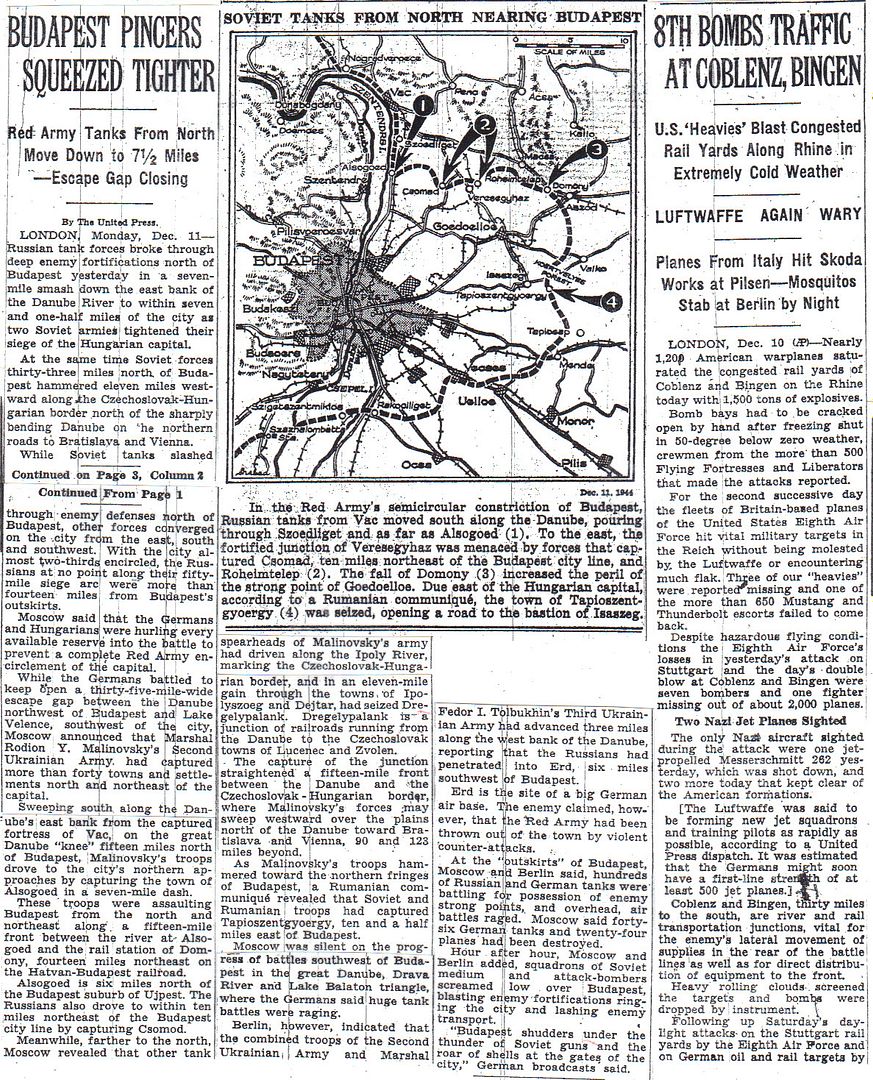
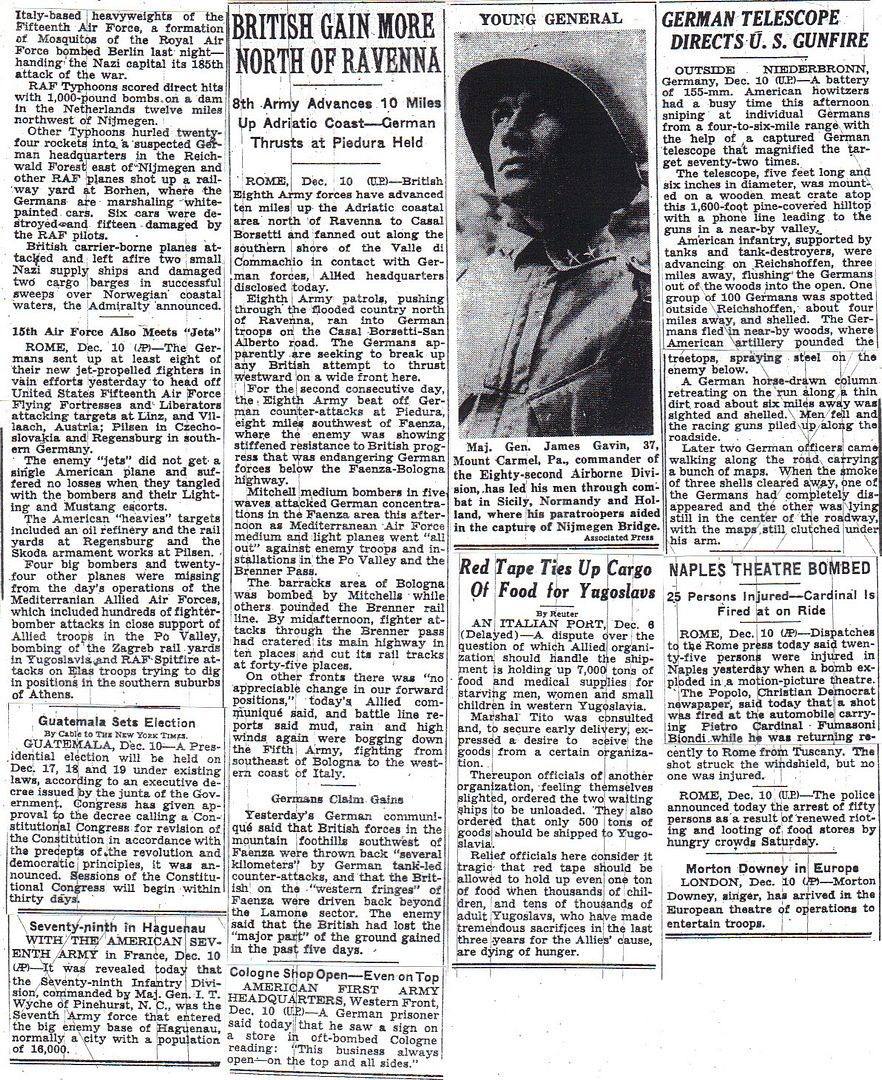
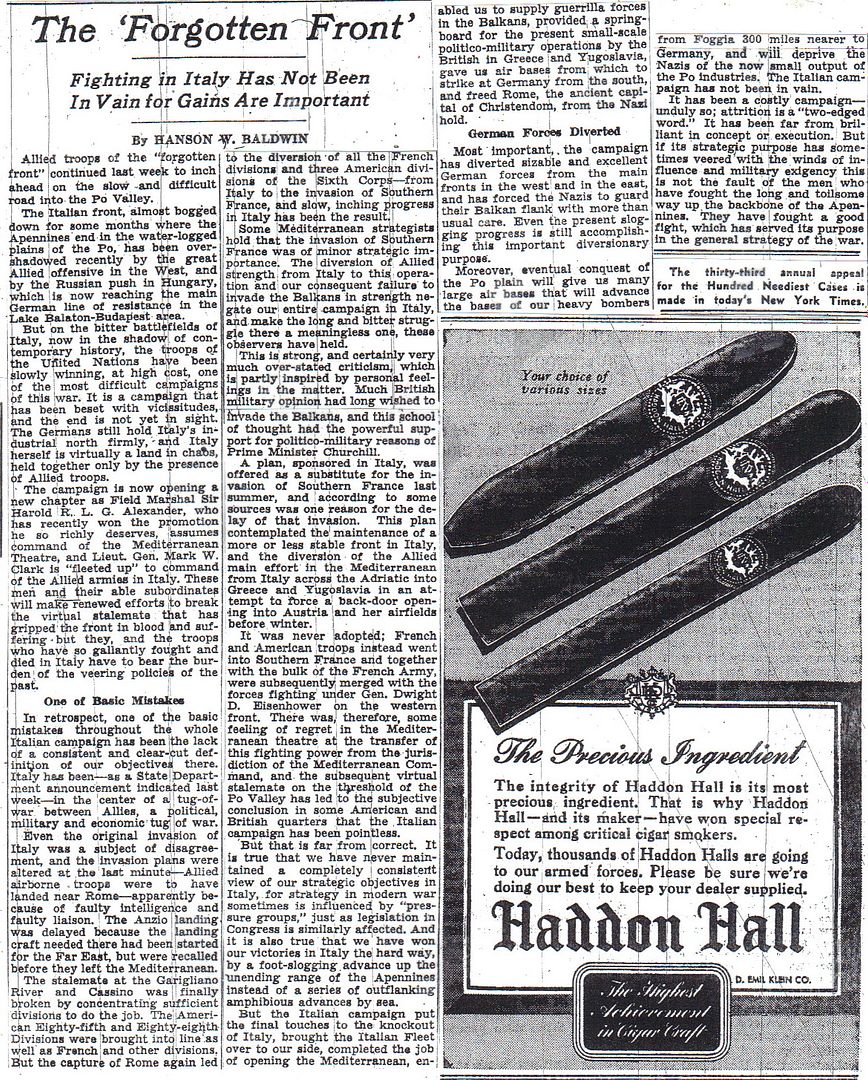
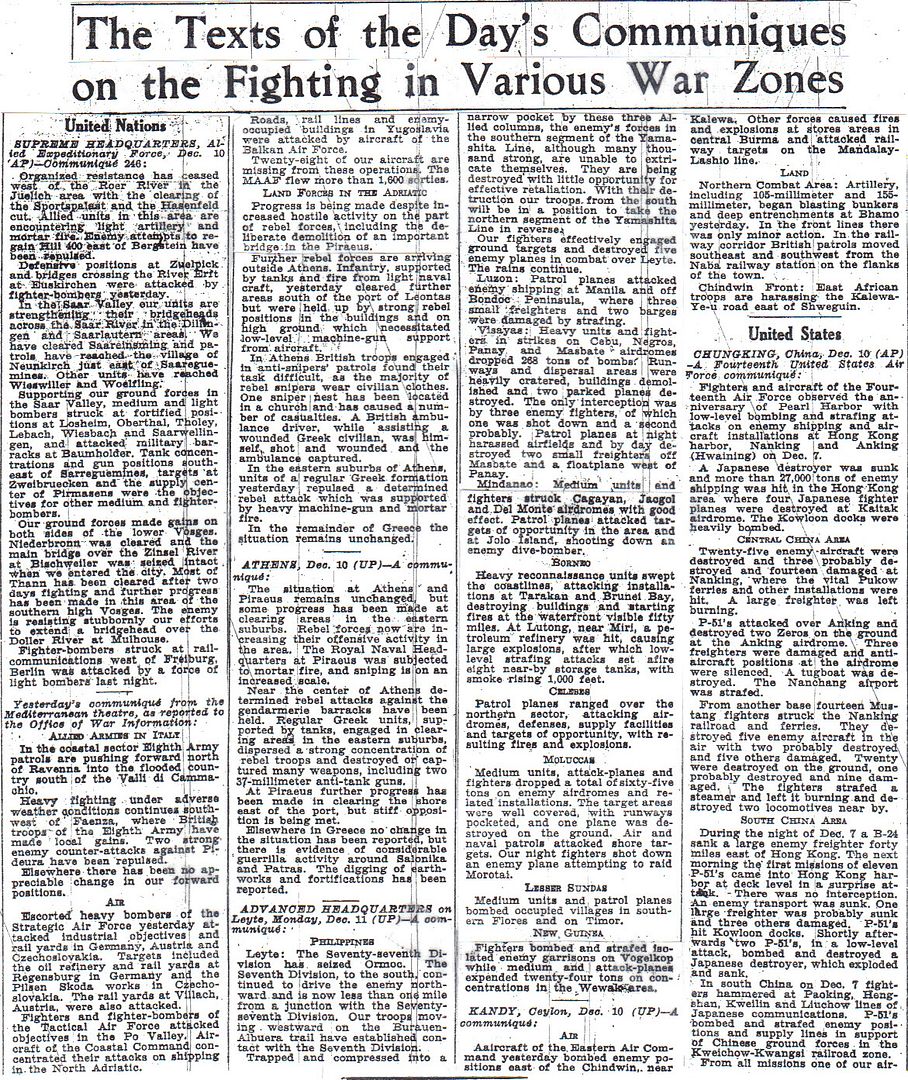

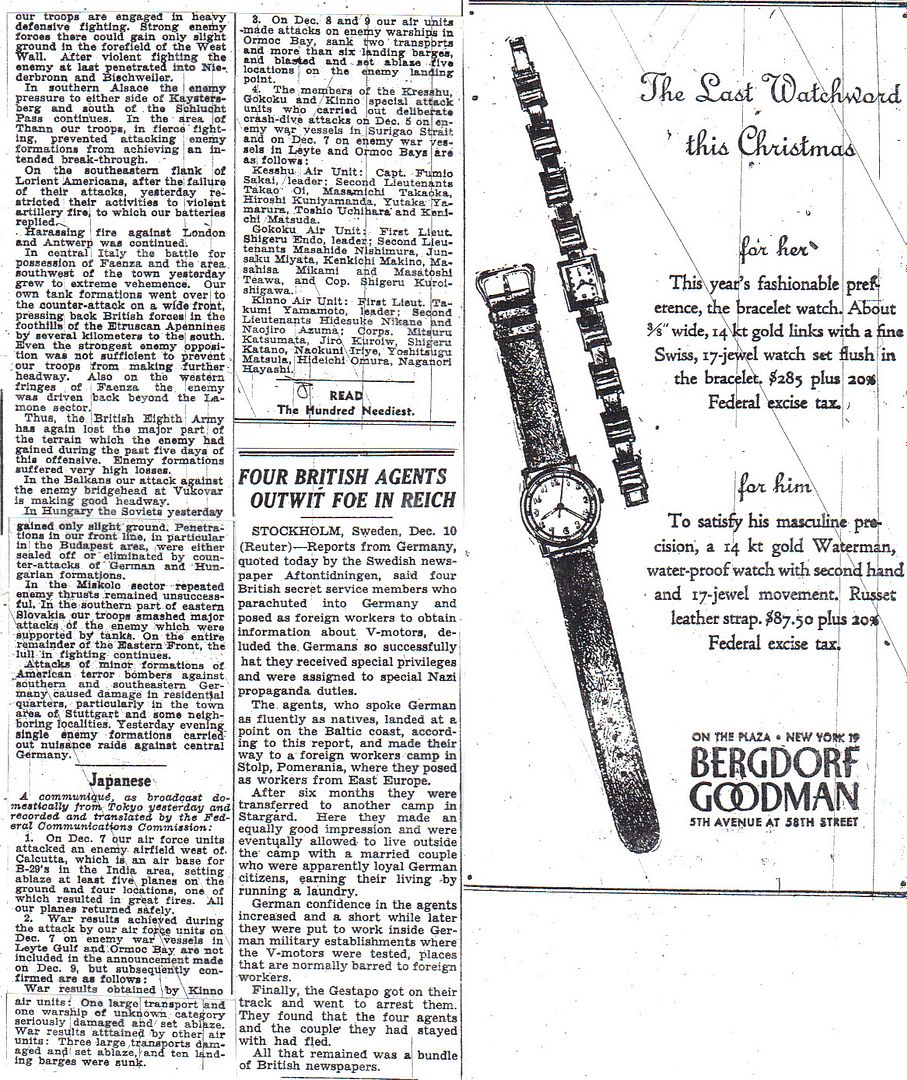
http://www.onwar.com/chrono/1944/dec44/11dec44.htm#
Soviets target Budapest
Monday, December 11, 1944 www.onwar.com
On the Eastern Front... Soviet forces are approaching Budapest, the capital of Hungary. The city is subjected to intensive artillery bombardment and air strikes during the day. A Soviet communique claims Soviet troops are within 5 miles of Budapest in the north.
On the Western Front... Forces of the US 7th Army enter Haguenau in Alsace and advances southeast of Rohrbach. There are German counterattacks against the US 3rd Army bridgeheads over the Saar River which are repulsed.
Over Germany... Over 2000 USAAF bombers of the 8th and 15th Air Forces attack various rail targets in Germany as well as an oil plant and ordnance depots near Vienna (annexed Austria).
In Liberated Greece... British reinforcements reach Athens. It is estimated that the rebellious ELAS forces number 25,000 troops.
In the North Atlantic... German torpedo planes and U-365 attack convoy RA62. The British destroyer Cassandra is damaged and the U-boat is sunk.
http://www.etherit.co.uk/month/11/11.htm
December 11th, 1944 (MONDAY)
UNITED KINGDOM: Minesweeper HMS Lioness commissioned.
Frigate HMCS Monnow attacked by A JU88 torpedo bomber that had suddenly appeared out of the overcast skies. Within seconds Monnow opened fire with bridge Oerlikons and registered a hit. Later, returning to station, Monnow sighted flares and upon investigating picked up 4 German airmen from a raft. They were the crew of the JU88. Picked up and eventually turned over to authorities in Greenock. Monnow later proceeded to Londonderry.
During the night of 11/12 December, the USAAF Eighth Air Force flies Mission 747: three B-17 Flying Fortresses and eight B-24 Liberators drop leaflets in France, the Netherlands and Germany; one B-24 is lost.
FRANCE: French women dance for joy as they are freed from a German prison in the Alsatian town of Hagenau during its liberation today.
In the U.S. Third Army’s XII Corps area, the 137th Infantry Regiment, 35th Infantry Division finishes clearing Sarreguemines, except for a few snipers, and blocks at Frauenberg; the main body of the division continues toward the Blies River; at night, the division prepares to attack across the Blies on 12 December. The 328th Infantry Regiment, 26 Infantry Division, continues toward the German frontier.
In the U.S. Seventh Army’s XV Corps area, the elements of the 44th Infantry Division take Petit RC)derching; others reach Siersthal. In the VI Corps area, Haguenau falls to the 79th Infantry Division.
GERMANY: Bad Neuheim: At his Adlerhorst headquarters near Bad Nauheim about 16 miles (26 kilometers) north-northeast of Frankfurt, German western front commanders note Chancellor Adolf Hitler’s uncontrollable trembling and pale, puffy appearance as he orders Operation AUTUMN MIST, a major offensive through the Ardennes towards Antwerp.
In the U.S. First Army’s VII Corps area, the Germans continue a successful defense of Pier and Schophoven, but elements of the 415th Infantry Regiment, 104th Infantry Division, take Merken and Vilvenich. The 60th Infantry Regiment, 9th Infantry Division, and armor of the 3d Armored Division overrun Geich. Combat Command R of the 3d Armored Division, reinforced by a battalion of the 60th Infantry Regiment, makes a futile and costly effort to take Hoven. The 39th Infantry Regiment, 9th Infantry Division, seizes Merode and Schlicht. In the VIII Corps area, the 106th Infantry Division, with the 14th Cavalry Group (Mechanized) attached, takes over positions in the Schnee Eifel formerly held by the 2d Infantry Division.
In the U.S. Third Army’s XX Corps area, 3 the 57th Infantry Regiment, 90th Infantry Division withdraws a little on the north flank of the Diilingen bridgehead in order to shorten the front and secure supply lines; the 359th and 358th Infantry Regiments attempt in vain to find a passage through the fortified belt between them; the 359th loses three pillboxes during a counterattack; the 90th Reconnaissance Troop takes responsibility for the west bank of the Sarre River so that the covering force previously deployed there can be used to strengthen the bridgehead. 95th Infantry Division expands Saariautern bridgehead in costly fighting: the 377th Infantry Regiment pushes to the center of Fraulautern; the 378th clears about five city blocks in Ensdorf; the progress
of 379th in Saarlautern-Roden is negligible.
The USAAF Eighth Air Force flies Mission 746: The largest number of bombers so far dispatched, 1,586, and 841 fighters are sent to hit rail targets and bridges in western Germany using Pathfinder Force means; five bombers and two fighters are lost: 365 B-17 Flying Fortresses bomb the marshalling yard (M/Y) at Giessen, 320 hit the M/Y at Frankfurt-am-Main and 135 attack the Mosel M/Y at Koblenz while 304 B-24 Liberators attack the M/Y at Hanau with the loss of four B-24s. B-17 crews also bomb a railroad bridge at Mannehim by 182 aircraft with the loss of one aircraft while 158 B-24s bomb a railroad bridge at Maximiliansau. Fourteen other aircraft hit targets of opportunity.
Over 200 USAAF Ninth Air Force bombers dispatched to bomb defended villages and storage areas are recalled because of weather; one bomber manages to bomb a stores depot at Reichenbach. Fighters escort the RAF, divebomb targets in cities, and support the U.S. 3d Armored Division in the Echtz-Geich area, the 104th Infantry Division at Merken, the 9th Infantry Division at Merode and Derichsweiler, and the 83d Infantry Division at Strass.
During the day, RAF Bomber Command aircraft attack three cities: (1) 233 Lancasters and five Mosquitos are dispatched to the Urft Dam at Heimbach; 180 aircraft bomb the target. Hits are scored but no breach is made; one Lancaster is lost. (2) Two targets in Bottrop are bombed by 148 Lancasters through cloud on the marshalling yards (96 aircraft) and on the benzol plant (52 aircraft). The bombing appears to be accurate; one Lancaster is lost. (3) Duisburg is attacked by 80 Mosquitos on Oboe-leader raids to the Bruckhausen coking plant (49 aircraft) and to the Meiderich benzol plant (31 aircraft). Most of the bombing on the benzol plant and approximately half on the coking plant appeared to be accurate. No aircraft lost.
During the night of 11/12 December, RAF Bomber Command Mosquitos attack six cities: 38 bomb Hannover, 25 hit Hamburg, eight each attack Bielefeld and Schwerte and one each bomb Dortmund and Oberhausen. One Mosquito is lost.
U-2367 laid down.
U-2534 launched.
U-2349 commissioned.
AUSTRIA: Four hundred thirty five USAAF Fifteenth Air Force B-17 Flying Fortresses and B-24 Liberators, with fighter escorts, are dispatched to attack numerous targets: In Vienna, 205 bomb the Moosbierbaum benzine refinery with the loss of eight aircraft, 98 hit the Matzleinsdorf railroad station with the loss of five aircraft and 59 attack the South ordnance depot with the loss of three aircraft; 48 bomb the Main marshalling yard at Graz with the loss of one aircraft; and 31 bombers attack targets of opportunity.
HUNGARY: One each USAAF Fifteenth Air Force bombers bomb the railroad at Kenyeri, the city of Szombathely and an airfield.
ITALY: In the U.S. Fifth Army’s British XIII Corps area, the 6th Armoured Division is ordered to attack for Tossignano during the night of 12/13 December.
In the British Eighth Army’s Canadian I Corps area, the Canadian 1st Division and 5th Armoured Division gain bridgeheads across the Lamone River and push to the Fosso Vecchio Canal. Tanks are unable to cross into the bridgehead. The Porter Force is dissolved, but elements continue to assist the 5th Armored Division.
USAAF Twelfth Air Force medium bombers hit the Motta di Livenza bridge; fighters and fighter-bombers hit occupied areas, houses, guns, and defensive positions south of Bologna and attack railroad targets in the central Po River Valley.
YUGOSLAVIA: Thirty eight RAF bombers of No. 205 (Heavy Bomber) Group fly a supply mission to partisans.
CHINA: U.S. Lieutenant General Albert Wedemeyer, Commanding General U.S. China Theater of Operations and Chief of Staff to Chinese Generalissimo Chiang Kai-shek, Chairman of the National Government, drafts directives for Operation ALPHA (the plan to defend Kunming and Chungking) that Chiang Kai-shek later approves. Chinese General Ying-chin Ho, Commander-in-Chief Chinese Army General Headquarters, is to command ALPHA forces, but U.S. Major General Claire Chennault, Commanding General USAAF Fourteenth Air Force, will command air forces in the area. ALPHA forces are to complete concentration in the Kweiyang area, protect Kunming and Kweiyang, and train reserves.
Sixteen USAAF Fourteenth Air Force fighter-bombers attack Tien Ho Airfield at Canton and the Kengtung barracks.
BURMA: Twelve USAAF Tenth Air Force B-25 Mitchells hit the stores area at Hpaklon. Sixteen P-47 Thunderbolts support ground forces in the Bhamo area while 21 P-47s knock out and damage bridges at Mongmit, Man Aitau, Ho-hko, and Pa-mao. Seven fighter-bombers severely damage the Hsipaw ferry; supply and personnel concentrations and town areas are hit at Lawa, Myitson, Pemnegon, Nam Pan, Hsenwi, and Nawngpeng.
Twelve USAAF Fourteenth Air Force B-25 Mitchells bomb and fighter-bombers attack Lashio, and Wan Lai-Kam.
FRENCH INDOCHINA: Six USAAF Fourteenth Air Force B-24 Liberators and six B-25 Mitchells, supported by eight P-51 Mustangs, bomb the Hai Duong area.
PACIFIC OCEAN: In the Bohol Sea, Japanese planes attack a resupply convoy of 13 USN medium landing ships (LSMs) and landing craft, infantry (LCIs), bound for Ormoc Bay, Leyte, Philippine Islands; escorting destroyer USS REID (DD-369) shoots down seven aircraft but is sunk by two kamikazes off the southern coast of Leyte about 75 nautical miles (140 kilometers) south-southeast of Ormoc in position 09.50N, 124.55E; 52 of her crew are lost. Her 150 survivors are picked up by landing craft in her convoy. Reid receives seven battle stars for World War II service. (Ron Babuka & Jack McKillop)
In the Visayan Sea, USMC F4U Corsairs repeat a mast-head attack on a Japanese convoy about 31 nautical miles (57 kilometers) northwest of Ormoc, Leyte, in position 11.20N, 124.10E.
COMMONWEALTH OF THE PHILIPPINES:
In the U.S. Sixth Army’s X Corps area on Leyte, 1st Squadron, 12th Cavalry Regiment (Infantry), 1st Cavalry Division, reduces the strongpoint north of its perimeter in the Mt. Cabungaan area after intense preparatory fire. Patrols of the 2d Squadron, 7th Cavalry Regiment (Infantry), probe both sides of the ridge southeast of Limon before the general frontal and flanking attack is begun behind artillery bombardment; the advance stops for the night at the base of the hill. The 128th Infantry Regiment, 32d Infantry Division, begins patrolling the Limon area. The XXIV Corps gains firm control of Ormoc Bay as advance elements of the 7th Infantry Division overtake the 77th Infantry Division troops at Ipil. Japanese forces on Leyte are thus divided. The 77th Infantry Division attacks from Ormoc with the 307th and 306th Infantry Regiments but makes little progress. Japanese attempts to land reinforcements at Ormoc Bay, during the night of 11/12 December, are frust rated. A few Japanese succeed in landing but are unable to take an active part in the battle for the Ormoc corridor.
USAAF Far East Air Forces B-24 Liberators bomb Mandurriao Airfield on Cebu Island. B-25 Mitchells, with P-47 Thunderbolt support, hit Padada Aerodrome on Mindanao Island and Fifth Air Force fighters join U.S. Marine Corps aircraft in attacks on a 13-ship convoy off northwestern Leyte Island. Leyte-based planes begin missions in support of the coming invasion of Mindoro.
USN submarine USS Gar (SS-206) lands supplies on the west coast of Luzon, and picks up intelligence documents.
EAST INDIES: In the Netherlands East Indies, USAAF Far East Air Forces (FEAF) B-25 Mitchells, A-20 Havocs, and fighter-bombers attack Japanese supply and troop concentrations on the southern shore of Wasile Bay on Galela Island off Morotai and along the shores of north Halmahera, sinking a freighter. Other FEAF planes make small raids on oil and shipping targets around northern Borneo.
VOLCANO ISLANDS: Twenty eight USAAF Seventh Air Force B-24 Liberators from Guam bomb the airfield and ammunition storage area on Iwo Jima; night harassment continues as individual B-24 Liberators from Guam and Saipan fly three snooper strikes against the island during the night of 11/12 December.
CAROLINE ISLANDS: USN Task Force 38 (TF 38) sails from Ulithi Atoll to participate in the invasions of Mindoro and Luzon Islands, Philippine Islands. TF 38 consists of six aircraft carriers (CVs) and six small aircraft carriers (CVLs) with six carrier air groups (CVGs), five light carrier air groups (CVLGs) and one night light carrier air group [CVLG(N)] .
- Task Group (TG) 38.1: USS Cowpens (CVL-25) with CVLG-22, USS Monterey (CVL-26) with CVLG-28), USS Wasp (CV-18) with CVG-81 and USS Yorktown (CV-10) with CVG-3.
- TG 38.2: USS Cabot (CVL-28) with CVLG-29, USS Hancock (CV-19) with CVG-11, USS Independence (CVL-22) with CVLG(N)-41 and USS Lexington (CV-16) with CVG-20
- TG 38.3: USS Essex (CV-9) with CVG-4, USS Langley (CVL-27) with CVLG-44), USS San Jacinto (CV-30) with CVLG-45) and USS Ticonderoga (CV-14) with CVG-80).
SOLOMON ISLANDS: On Bougainville, the Australian 11th Brigade, 3rd Division, relieves the U.S. 148th Infantry Regiment, 37th Infantry Division.
CANADA:
Corvette HMCS North Bay arrived Sydney, Nova Scotia for refit.
Tug HMCS Gleneagle launched Kingston, Ontario.
U.S.A.: The remains of a paper Japanese Fu Go paper balloon including envelope, rigging and some apparatus, is recovered at Kalispell, Montana. It is believed that the balloon landed between 11 and 25 November. Kalispell is located about 150 miles (241 kilometers) northwest of Great Falls.
Destroyer USS Frank Knox commissioned.
Frigate USS Moberly commissioned.
ATLANTIC OCEAN: On 10 Dec, 1944, U-365 fired a Gnat at the convoy RA-62 in grid AC 8860 and heard a detonation after 10 minutes 58 seconds, probably at the end of its run. A Gnat struck destroyer HMS Cassandra from U-365, when she searched for the U-boat north of Varde, Norway to prevent a further attack on the convoy. The whole bow section was blown off. Frigate HMS Bahamas took her in tow stern first and passed later the tow over to a Soviet tug, which towed her to Kola Inlet for. In July 1945 the destroyer sailed to Gibraltar for complete repairs, which took over a year to complete and then went into reserve in 1946.
In the Caribbean Sea, the steady decline in U-boat activity in the Caribbean during the year permits a reduction of non-rigid airship (blimp) operations over the southern approaches, and Fleet Airship Wing Five at Trinidad is disestablished.
Quite a glamour-shot of Gen. Gavin on page 9.
Churchill forecasting that the German war will end by June 30.
Only six Essex-class carriers sortied with TF 38. Intrepid, Franklin and Bunker Hill have been returned to west coast yards to repair damage in the Leyte campaign. While there, they will also receive major overhauls and upgrades, particularly with AA and radar. The six active carriers represents the low point of USN carrier strength since a year ago.
But that’s the impressive thing about the United States Navy in World War 2: we can rotate fleet units back home for repairs, and at the same time perform significant upgrades and overhaul while there. Meanwhile we still conduct active operations with the most powerful fleet in the world. And we know there are more carriers working up to join them.
He could be right!
Defintely!
Speaking of the future, are you getting a feeling that the Germans are planning a last-ditch counterattack on the Western Front?
Even though the USN was down to 6 Essex class carriers we still had 6 or more of the Independence class light carriers as well as several dozen, at least, of escort carriers.
And as the Battle of Samar showed the CVEs could pack a punch.
The light carriers (CVL) were just a bit better than the escort carriers. The CVL air group was around 35 aircraft vs about 20 aircraft on a CVE. The CVLs chief asset was they could keep up with the Essex class carriers.
Regards
alfa6 ;>}
Hmmm...let me consult my crystal ball...
YES! I see it clearly!
:-)
The CVEs were really underrated in most history books. They were vital in providing air cover for amphibious operations. In essence, nothing was out of range of American air power because we could bring it with us. Those CVEs did a great job of freeing up the fast carriers to roam farther afield and stand ready to fight the Japanese fleet if it showed up.
I wish you’d have let me borrow that cyrstal ball on August 6 2013.
What an amazing picture.
Disclaimer: Opinions posted on Free Republic are those of the individual posters and do not necessarily represent the opinion of Free Republic or its management. All materials posted herein are protected by copyright law and the exemption for fair use of copyrighted works.